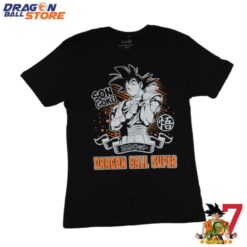All Of Single Dragon Ball Series (In Watch Order)

This is a compilation of all the Dragon Ball series, following the chronological order and spanning over three decades of episodes.
Since the release of its first manga chapter in 1984, Dragon Ball has had a rich and diverse history. This franchise goes well beyond just Super Saiyans, power levels, and villains who must be completely obliterated to meet their demise. With a long-running series like Dragon Ball, there have been various phases throughout its existence. Although the original manga bore the title Dragon Ball, Toei Animation decided to divide their adaptations into separate parts.
Furthermore, Dragon Ball expanded into an authorized continuation referred to as Dragon Ball GT. Despite the absence of Toriyama’s contribution, Dragon Ball has been persistently producing fresh material for many years. The anime was replaced by video games as the primary product for a while. However, Dragon Ball Super and the most recent movie, Super Hero, have confirmed that the series’ anime is an ongoing entity.
See more: Dragon Ball T-Shirt
What are all the Dragon Ball series in order?
1. Dragon Ball (1986 – 1989)
153 Episodes, 7 Story Arcs
The original anime adaptation of Dragon Ball is considered by many to be the top of-the-line. Unlike Dragon Ball Z, the anime does a better job of adapting its story arcs and has fewer instances of inconsistent animation or uncomfortable filler. In fact, the added filler content in Dragon Ball serves to enhance the main story by building on what was originally presented in the manga.
It is noteworthy that Dragon Ball’s transformation into Dragon Ball Z can be linked to the 23rd Tenkaichi Budokai, where the majority of the team that would ultimately create DBZ began their work on the show. The pace of the 23rd Tenkaichi Budokai is considerably slower than previous episodes, taking full advantage of each moment. Even though this type of pacing would eventually become a significant issue for Dragon Ball Z, it adds weight to DB’s final tournament.
2. Dragon Ball Z (1989 – 1996)
291 Episodes, 5 Story Arcs
Dragon Ball Z can be seen as a direct extension of Dragon Ball in many ways. Its initial episode was broadcasted just a week after the final episode of Dragon Ball. Interestingly, the opening episode of DBZ was designed as a Dragon Ball episode instead of being specifically labeled as Dragon Ball Z Episode 1. This rebranding decision turned out to be a success as it revitalized the anime’s crew, finances, and appeal. Despite its sometimes convoluted plot, Dragon Ball Z has amassed a massive fan following due to its undeniable popularity.
Dragon Ball Z starts off with Toei Animation’s finest work in terms of Dragon Ball, showcasing near-perfect adaptation of Toriyama’s fight choreography and exceptional performances from the Japanese voice cast in the Saiyan arc. The fight between Goku and Vegeta reaches a level of animation quality comparable to that of a movie. Right from the beginning, Dragon Ball Z established itself as a grandiose series. Even though it covers only five story arcs and one filler arc, Dragon Ball Z became the longest-running anime adaptation of the Dragon Ball franchise.
3. Dragon Ball GT (1996 – 1997)
64 Episodes, 3 Story Arcs
Although the popularity of the series declined after the manga ended, Toei decided to create one final sequel called Dragon Ball GT. This new anime-only series was completely based on fresh material and served as a follow-up to the Buu arc. It’s important to mention that while GT is not considered part of the main series, it is considered part of the original anime’s continuity according to Toei. Therefore, Toei’s animated canon for Dragon Ball included the first Dragon Ball adaptation, Dragon Ball Z, and Dragon Ball GT.
The final installment of DBZ smoothly connects to the inaugural episode of GT, featuring a preview of the next episode as a continuation of the Dragon Ball to Z transition. Dragon Ball GT was not well-received upon its initial release and continues to be criticized by fans, although its reputation has slightly improved in recent times. With unoriginal elements, unimpressive fight sequences, and uninspired content, Dragon Ball GT was an unsatisfactory conclusion to the anime series.
4. Dragon Ball Kai (2009 – 2011)
167 Episodes, 3 Story Arcs
To coincide with the 20th anniversary of Dragon Ball Z, Toei made the decision to revise the show in order to better align it with Akira Toriyama’s original manga. This resulted in the creation of Kai, which features reworked scenes, a reduced number of episodes, a fresh score by Kenji Yamamoto, and some solid voice acting. While some aspects are more successful than others depending on the storyline, Kai provides a more streamlined viewing experience of Dragon Ball Z.
Dragon Ball Z fans may not get to experience everything that made the anime so enjoyable, but Kai presents a fresh take on Z’s initial three-story arcs, particularly by transforming the Frieza arc into a tolerable animated form. While the Saiyan arc falls short, the new music score fits this section of the story better, and Kai’s conclusion at the Cell arc provides a satisfying ending.
5. Dragon Ball Kai: The Final Chapters (2014 – 2015)
69 Episodes, 1 Story Arc
Overall, Kai: The Final Chapters is not a satisfying continuation of the original Dragon Ball Kai. Although Kai had its flaws, such as unnecessary filler that could have been removed, it had a clear direction and did not have a greenish hue distorting the entire screen. Unfortunately, The Final Chapters also lacks an original score due to the dismissal of Kenji Yamamoto, resulting in a painfully generic soundtrack.
The Final Chapters seems to lack enough substantial changes to make it worthwhile. Specifically, the Buu arc in the animated version still feels excessively long, and the performances in the Japanese version are generally not up to par. On the other hand, the English dub is impressive and consistent with Kai’s style, making it worthwhile to watch both Kai and The Final Chapters in English for the positive qualities they offer.
6. Dragon Ball Super (2015 – 2018)
131 Episodes, 5 Story Arcs
The abrupt conclusion of Dragon Ball Super with the Tournament of Power took everyone by surprise. Even with additional canon material like Dragon Ball Super: Broly and Super Hero, the manga has become the primary focus, encompassing three complete story arcs since ToP. Despite its flaws, Dragon Ball Super remains a captivating series. Unfortunately, early scheduling issues resulted in a lackluster and disappointing start that left numerous fans dissatisfied.
From the Goku Black arc onwards, Dragon Ball Super introduced some of the tension that was characteristic of Dragon Ball Z. As the Tournament of Power approached, the production quality of Dragon Ball Super appeared to have improved significantly. Although the show may have weaknesses in terms of storytelling, it manages to maintain a better sense of continuity within the Dragon Ball universe. Even when the plot or character development falls short, there are frequent episodes that focus on the everyday lives of the characters, which serves as a reminder to viewers of their affection for the Dragon Ball cast.
7. Super Dragon Ball Heroes (2018 – Present)
46 Episodes (Ongoing), 7 Story Arcs
Although Dragon Ball Super has ended, the animated aspect of the franchise has remained active through Super Dragon Ball Heroes since 2018. It is essential to acknowledge that the episodes of Super Dragon Ball Heroes are distinct as they are approximately six minutes long and serve primarily as promotional material despite having a narrative.
While it’s true that Super Dragon Ball Heroes doesn’t always deliver impressive animation, there are occasional moments where it manages to produce some high-quality visuals. Additionally, the show’s fast-paced and chaotic storyline can be enjoyable to immerse oneself in. The creators of the anime seem to have a clear understanding that they have the freedom to take the plot in any direction they please, which is a strength of the Dragon Ball series.











Related post
How Many Dragon Ball Series Are There?
Hey there, fellow anime enthusiasts! If you’ve ever cast a nostalgic glance back to your Saturday morning cartoon days or binge-watched episodes of a certain
Who Created Dragon Ball?
Hey there, fellow anime and manga enthusiasts! Today, let’s dive deep into the vibrant world of Dragon Ball, one of the most iconic franchises that
5 Theories About the Future of Dragon Ball Super
Hey there, Dragon Ball fans! If you’re anything like me, you’ve spent countless hours not just watching Goku and his friends save the universe but
Top 10 Goku Battles with Villains That Fans Can’t Forget
Hey there, Dragon Ball fans! Grab your capsules and power up your Instant Transmissions because we’re diving into a blast-from-the-past as we celebrate our favorite
10 Signature Goku Moves That Define the Saiyan Warrior
Hey there, fellow Dragon Ball fans! If you’re reading this, I’m pretty sure you’ve experienced the thrill of watching Goku power up, launch into an